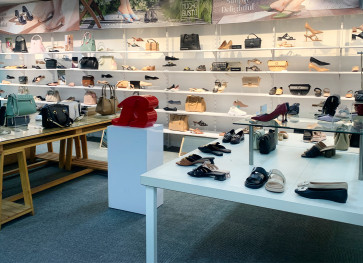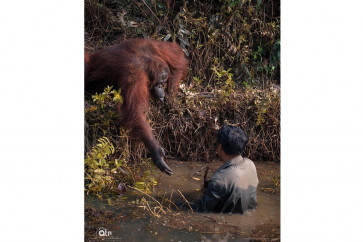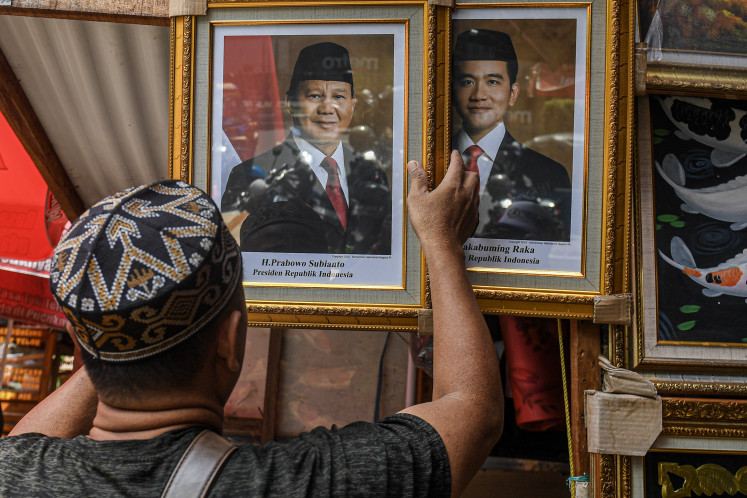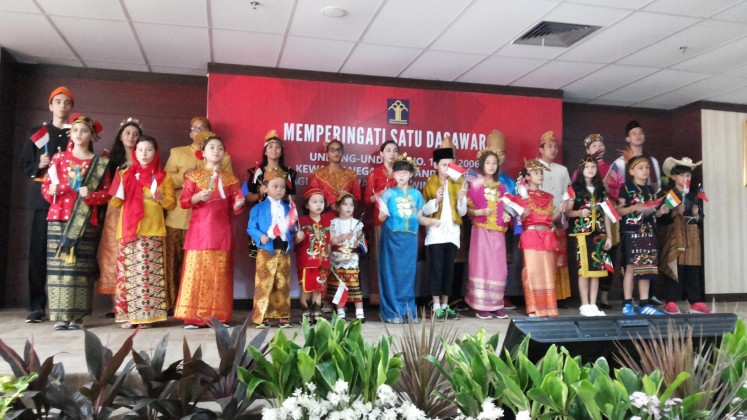'Market Share' showcase: Responding to Reality
Beautification: Vendors attend to their goods in front a wall adorned by a mural by The Popo at the East Tebet market, South Jakarta
Change Size
 Beautification: Vendors attend to their goods in front a wall adorned by a mural by The Popo at the East Tebet market, South Jakarta.(Courtesy of Goethe Institute)" height="338" border="0" width="510">Beautification: Vendors attend to their goods in front a wall adorned by a mural by The Popo at the East Tebet market, South Jakarta.(Courtesy of Goethe Institute)
Beautification: Vendors attend to their goods in front a wall adorned by a mural by The Popo at the East Tebet market, South Jakarta.(Courtesy of Goethe Institute)" height="338" border="0" width="510">Beautification: Vendors attend to their goods in front a wall adorned by a mural by The Popo at the East Tebet market, South Jakarta.(Courtesy of Goethe Institute)People with different colored plastic bags made their way through crowded alleys, laughing as they scurried from one shop to another as The Connector â a blue bajaj (motorized pedicab) â pulled up in the parking lot of Pasar Tebet Timur market in South Jakarta.
From the outside the bajaj looked like any other but inside, it gleamed with pink and twinkling accessories.
Speaking through a bullhorn, Indonesian artist Putri Ayu Lestari offered people free trips between Pasar Tebet Barat and Pasar Tebet Timur.
âThese two markets are still rivaled by big supermarkets. So for both, sellers and buyers, the markets have to be easily accessible and connected,â explained Ayu of her work.
Her art project is part of the âMarket Shareâ showcase, held as part of the Jerman Fest â organized by the Goethe-Institut Indonesien, the German Embassy in Jakarta and EKONID, the German-Indonesian Chamber of Industry and Commerce â to commemorate and celebrate the friendship between Germany and Indonesia.
Market Share serves as a space for 10 young artists â five from the Städelschule fine arts academy in Frankfurt, Germany, and five from artistsâ initiative ruangrupa in Indonesia â to use artistic approaches in response to the reality in two markets in Tebet, South Jakarta.
The artists are Angga Cipta, Bertrand Flanet, Edi Winarni, Hanna-Maria Hammari, Julia Zabowska, Liesel Busrich, Maharani Mancanagara, Muhammad Fatchurofi, The Popo and Putri Ayu.
These artists, selected by curators Tobias Rehberger and director of ruangrupa Ade Darmawan, have been actively churning out public art. During the project, they conducted research and observations to create their works. Some collaborated with local vendors and their works will be owned by Pasar Tebet Timur once the exhibition ends.
âIt is never easy to work in a public space,â said Rehberger, who was awarded the Golden Lion for best artist at the 53rd Venice Biennale for his installation piece, Cafeteria.
âYou have to consider things that you do not consider when you work in a museum. That is challenging but it also brings out things that museums cannot provide.â
Resulting from this, vendors and customers can now appreciate 10 different works at the market, which mainly supplies daily needs for the local community.
A market is not a museum and its surroundings and offered goods often have another function to that intended.
Indonesian artist Fatchurofi has created a kind of showroom for transformed items named Make-Sip â Makeshift behind the market. The purpose is not about buying and selling goods, it is about the transaction of ideas.
âWhen I went to public spaces, especially in Jakarta, I saw that the people were using anything to fulfill their needs for temporary solutions,â he said, describing his artwork.
The market acts as a venue for fulfilling the needs of the urban community.
 Beautification: <)
Beautification: <)
B
span class="inline inline-center">Beautification: Vendors attend to their goods in front a wall adorned by a mural by The Popo at the East Tebet market, South Jakarta.(Courtesy of Goethe Institute)
People with different colored plastic bags made their way through crowded alleys, laughing as they scurried from one shop to another as The Connector ' a blue bajaj (motorized pedicab) ' pulled up in the parking lot of Pasar Tebet Timur market in South Jakarta.
From the outside the bajaj looked like any other but inside, it gleamed with pink and twinkling accessories.
Speaking through a bullhorn, Indonesian artist Putri Ayu Lestari offered people free trips between Pasar Tebet Barat and Pasar Tebet Timur.
'These two markets are still rivaled by big supermarkets. So for both, sellers and buyers, the markets have to be easily accessible and connected,' explained Ayu of her work.
Her art project is part of the 'Market Share' showcase, held as part of the Jerman Fest ' organized by the Goethe-Institut Indonesien, the German Embassy in Jakarta and EKONID, the German-Indonesian Chamber of Industry and Commerce ' to commemorate and celebrate the friendship between Germany and Indonesia.
Market Share serves as a space for 10 young artists ' five from the Städelschule fine arts academy in Frankfurt, Germany, and five from artists' initiative ruangrupa in Indonesia ' to use artistic approaches in response to the reality in two markets in Tebet, South Jakarta.
The artists are Angga Cipta, Bertrand Flanet, Edi Winarni, Hanna-Maria Hammari, Julia Zabowska, Liesel Busrich, Maharani Mancanagara, Muhammad Fatchurofi, The Popo and Putri Ayu.
These artists, selected by curators Tobias Rehberger and director of ruangrupa Ade Darmawan, have been actively churning out public art. During the project, they conducted research and observations to create their works. Some collaborated with local vendors and their works will be owned by Pasar Tebet Timur once the exhibition ends.
'It is never easy to work in a public space,' said Rehberger, who was awarded the Golden Lion for best artist at the 53rd Venice Biennale for his installation piece, Cafeteria.
'You have to consider things that you do not consider when you work in a museum. That is challenging but it also brings out things that museums cannot provide.'
Resulting from this, vendors and customers can now appreciate 10 different works at the market, which mainly supplies daily needs for the local community.
A market is not a museum and its surroundings and offered goods often have another function to that intended.
Indonesian artist Fatchurofi has created a kind of showroom for transformed items named Make-Sip ' Makeshift behind the market. The purpose is not about buying and selling goods, it is about the transaction of ideas.
'When I went to public spaces, especially in Jakarta, I saw that the people were using anything to fulfill their needs for temporary solutions,' he said, describing his artwork.
The market acts as a venue for fulfilling the needs of the urban community.

Ade of ruangrupa, a collective that is focused on visual arts and social cultural contexts particularly in urban space, said Pasar Tebet Timur had been selected as the site of the artworks as it was managed by the local government of Jakarta.
'[The art project is] an effort to transform and transfer traditional markets into a modern vision,' explained Ade, who is also chairman of the Jakarta Biennale Foundation.
The interaction between traditional and modern provides new scopes to interpret the interaction between sellers and buyers, as well as the market as a whole.
German artist Liesel saw a constant transition and visual competition in the market. With her project, titled There is nothing left to see, she claimed them. 'I found 60 slogans of my favorite choice of major tech and phone companies, translated them to Indonesian and sprayed them on 210 approved shutters.'
By translating them and giving them a place, they all become a question of ownership and advertisement as motivation. When the shutters are down, the slogans create a story about immateriality.
________________________________________
The writer is an intern at The Jakarta Post









